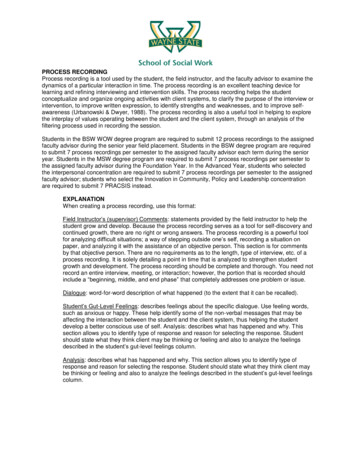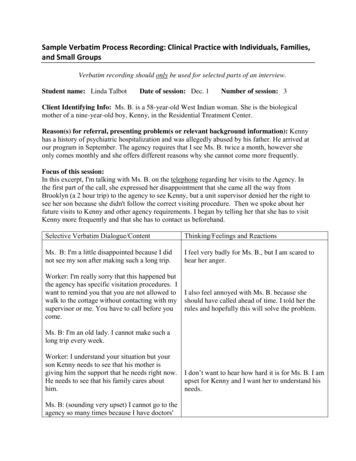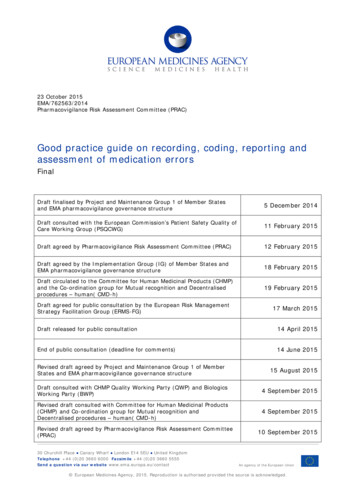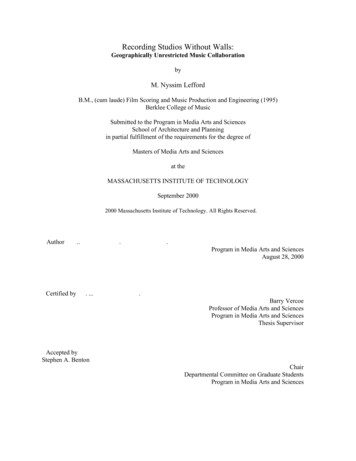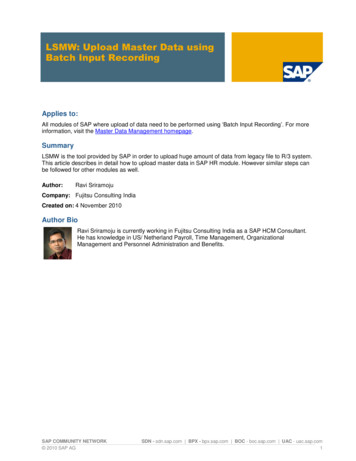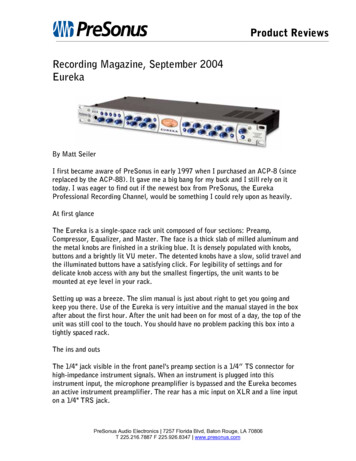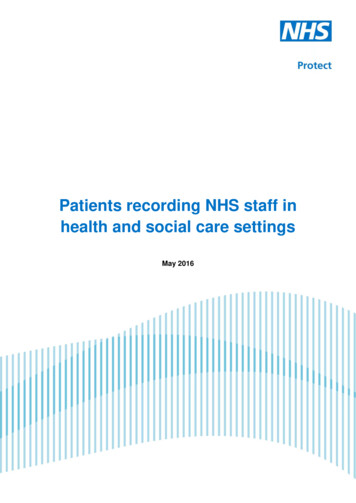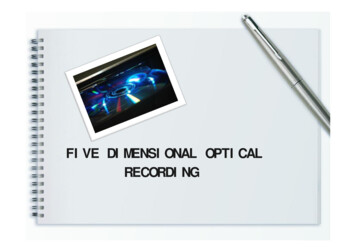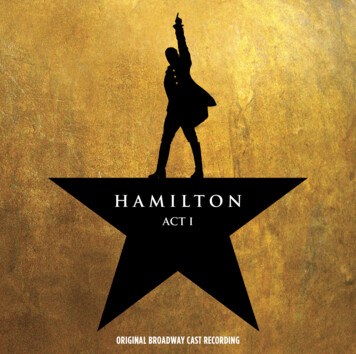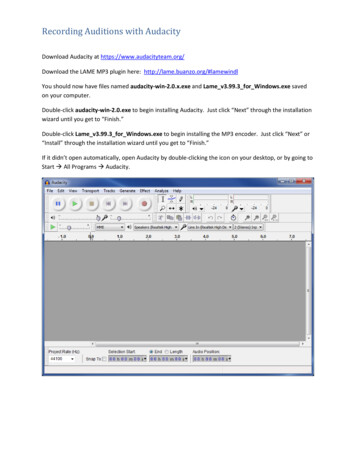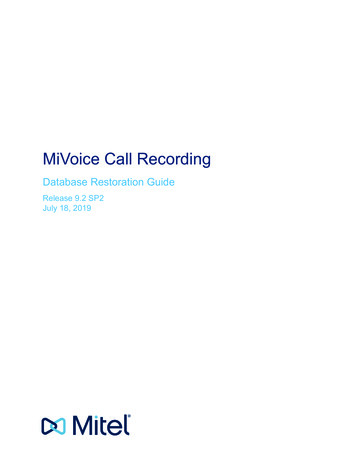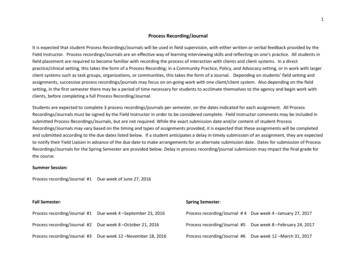
Transcription
1Process Recording/JournalIt is expected that student Process Recordings/Journals will be used in field supervision, with either written or verbal feedback provided by theField Instructor. Process recordings/Journals are an effective way of learning interviewing skills and reflecting on one’s practice. All students infield placement are required to become familiar with recording the process of interaction with clients and client systems. In a directpractice/clinical setting, this takes the form of a Process Recording; in a Community Practice, Policy, and Advocacy setting, or in work with largerclient systems such as task groups, organizations, or communities, this takes the form of a Journal. Depending on students’ field setting andassignments, successive process recordings/journals may focus on on-going work with one client/client system. Also depending on the fieldsetting, in the first semester there may be a period of time necessary for students to acclimate themselves to the agency and begin work withclients, before completing a full Process Recording/Journal.Students are expected to complete 3 process recordings/journals per semester, on the dates indicated for each assignment. All ProcessRecordings/Journals must be signed by the Field Instructor in order to be considered complete. Field Instructor comments may be included insubmitted Process Recordings/Journals, but are not required. While the exact submission date and/or content of student ProcessRecordings/Journals may vary based on the timing and types of assignments provided, it is expected that these assignments will be completedand submitted according to the due dates listed below. If a student anticipates a delay in timely submission of an assignment, they are expectedto notify their Field Liaison in advance of the due date to make arrangements for an alternate submission date. Dates for submission of ProcessRecordings/Journals for the Spring Semester are provided below. Delay in process recording/journal submission may impact the final grade forthe course.Summer Session:Process recording/Journal #1Due week of June 27, 2016Spring Semester:Fall Semester:Process recording/Journal #1Due week 4 –September 23, 2016Process recording/Journal # 4 Due week 4 –January 27, 2017Process recording/Journal #2Due week 8 –October 21, 2016Process recording/Journal #5Due week 8 –February 24, 2017Process recording/Journal #3Due week 12 –November 18, 2016Process recording/Journal #6Due week 12 –March 31, 2017
2INFORMATION THAT SHOULD GO INTO PROCESS RECORDINGThere are various formats for completing a process recording. The following outline covers the major areas to include within a processrecording. Students may use either the “column” format template (as shown in the “sample” that follows), or a narrative format (description ofthe interview/contact content and student’s observation/thoughts/feelings in paragraph form) for completing a process recording. All contentareas below must be included when using either format. Field Instructor comments can be added to any of the sections of the recording.1. Identifying information. Include student’s name, date of interview/contact, and date of submission to the field instructor. Identify the client(disguise or remove client name to protect confidentiality in submission to Field Liaison.) Include the number of times this client has beenseen (i.e., "Fourth contact with Mrs. S."). If client is seen in location other than the agency, state the general location where client was seen.2. “Tuning In”. This is the preparation phase of an interview/contact with client. Anticipate the client’s thoughts, feelings, issues, as they enterthe interview. Also consider your own thoughts and feelings as you anticipate this interview.3. Purpose and goal for the interview/contact. Brief statement of the purpose of the interaction and if there are any specific goals to beachieved, the nature of the presenting issues and/or referral.Column or Narrative format:a. Content. A description of what happened, as close to actual dialogue as the student can recall, should be completed. This section doesnot have to include a full session of dialogue but should include a portion of dialogue. The field instructor and student should discusswhat portions should be included in the verbatim dialogue.b. Reflection and feelings. The student's feelings and reactions to the client and to the interview. This requires the student to put intowriting unspoken thoughts and reactions s/he had during the interview e.g. "I was feeling angry at what the client was saying, not surewhy I was reacting this way ”c. Observation/Analysis. Thoughts about what has happened during the interview (e.g., Why is he acting this way?) and/or identification ofskills or theoretical/frameworks used.( e.g. “I used the strengths perspective “ ; “I used the skill of partializing.”)d. Field Instructor’s Comments.4. A summary of the student's impressions. This is a summary of the student's analytical thinking about the entire interview/contact and/or anyspecific interaction about which the student is unsure. What did you learn from this interview? Are there any patterns in your practiceemerging more distinctly?
35. Future plans/Next steps. Identify any unfinished business and/or any short/long term goals. Given all of the above, what are you planning todo next time with the client? Are there things that need to be researched, learned, or considered, prior to the next interview? Is youroverall purpose still appropriate?6. Identify questions for supervision. Include any client action or non-verbal activity that the student may want to discuss.7. Reflection on supervisory discussion with Field Instructor. Following supervision, discuss what you have learned about your practice, and thecompetencies and/or practice behaviors relevant to your learning.
4Sample Process RecordingContent DialogueRecord word for word (to the best of yourability) what happened during the selectedsegment of the interview, including bothverbal and nonverbal communication. Becertain to include third-person participants,interruptions, and other occurrences thatwere not part of the plannedsession/interview with the client.Reflection & FeelingsThe student’s feelings andreactions to the client and tothe interview as it takesplace. This requires puttinginto writing unspokenthoughts and reactions asthe interview is going on. Donot use this column toanalyze the client’s reactions– use it to identify and lookat your feelingsObservation/AnalysisThis column can be used toanalyze one’s own interviewingtechniques and to suggestalternate approaches thatmight have been moreeffective; or, one’s observationsand thoughts regarding whathas been happening during theinterview. E.g., in the course ofcarrying out the interview, thestudent is thinking: “I wonderwhat he really meant by thatstatement? That seems tocontradict what he told meearlier.”Field Instructor CommentsIn this column, the supervisorcan make remarks rightopposite the interaction,feeling level, or observationsthat have been recordedSample Content:This is a student’s third or fourth visit with a woman who is hospitalized with a life-threatening illness.**Adapted from Wilson, S (1980). Recording Guidelines for Social Workers. New York, NY: The Free Press. pp. 52-55.Content DialogueReflection & FeelingsWorker(W): (Knocking on closed door , thenwaling into room, smiling) Hello, SClient (C): (smiling) Hi. You’ve talked to B(patient’s husband) didn’t you? (begins tolaugh)That must have been on hermind for a while.Observation/AnalysisField Instructor Comments
5W: Yes I have Why are you laughing?(smiling, taking chair and placing it near thebed)That question could haveprobably been worded a littlebetter, perhaps more of astatement of fact – “This isamusing to you”C: Well, I called him up once on Sunday, andthen when I called him back later, hesounded different (smiling)W: (puzzled look on face) Different?I used the skill of reflectionhereC: The second time I called, he started askingquestions like, “Why do you think she wantsto talk to me?” and “What should I say?” (shebegins to laugh) Boy, he’s gonna give you ahard time.I wonder what she said tohim?W: Well, I explained to him that I would liketo meet him and maybe he would like todiscuss any concerns he may have regardingyour hospital stay, etc. I explained to himthat I would meet and speak with him alone,and then we could set up a time when wecould all meet together for a discussion.C: (smiling) Well, I hope you can get him tocome in!W: Your husband explained to me thatTuesday, around 7 pm would be a good timefor him to come in, after he gets home fromwork.I am hoping to clearly state thepurpose of my interview withhusband.It’s like a challenge to her, IsupposeAnything else?Did he ask any questions?
6C: If he comes in and talks to you it’ll besomething else! You see, the psychologistnever talked to him on the phone directly; heused to tell me to talk with my husband, butthen my husband won’t come. I swear, Bob’sso funny. He says, “I’m gonna tell her that youused to drink a lot.” But I told him that youalready know that, and a lot more. I told himthat I tell the doctors and others about mydrinking because, now the doctors says thatthat information was helpful in running testson me, and stuff like that. I told Bob that I tellthe truth about me, all he has to do is tell thetruth about himself (pause).His problem is that he keeps bringing up oldnews: he keeps bringing up things thathappened a long time ago. Like, one timebefore we were married, he saw me with aguy, and even now he says things like,“Remember when you were going out withme, and then I saw you going out withsomeone else?” And we weren’t evenmarried yet! And then the other day he wastalking about how my son was caught withtwo other boys for truancy. Anyway,. Theother two boys have been in the youthdetention facility a lot , and my son doesn’thave a criminal record, so they let him go. Butthat happened when I first got sick, and theman came to talk to me about it when I wasgetting ready to take the ambulance to thehospital. So my husband keeps saying that Itried to hide this from him, but I just hadMaybe her husband justneeded someone to say theywere going to listen to what hehad to say.Do you get the impressionshe’s scaring him off?She changed the subject.Perhaps she and her son dokeep information from herhusband. There are two sidesto every story!YES! Did you think of this atthe time?Was she surprised herhusband agreed to come?
7other things on my mind and I tried to tell myhusband (now picking and scratching arm,around IV site).The doctors came in this morning.(She had been smiling while previouslytalking, but stopped smiling when laststatement was being said.)W: It seems to me that their visit wasupsetting to you (pause).What would her husband do?Would he be physicallyabusive? Interpretation orquestioning neededYou still pick up nonverbalcues – nice.Attempting to interpret herchange in facial expression. TheIV seems to be a constantreminder of the reality of beingin the hospital.Good use of interpretation
8PROCESS RECORDING FOR GROUP SESSIONSA process recording can also be used when a student is co-facilitating/facilitating any type of group. Theprocess recording should include information regarding dialogue and non-verbal behaviors engaged inby specific members of the group. Group dialogue should show group interaction, to the extentpossible, to show an understanding of process, and/or to review with field instructor on groupdynamics.The Group Process Recording should also begin with the sections, as noted for the individual clientprocess recording:1.Identifying information. Include date of group meeting, and date of submission to the fieldinstructor. Identify the approximate number of group members and the number of times it has met, aswell as the location of the meeting.2.“Tuning In”. This is the student’s preparation phase for a group meeting. Anticipate the groupissues, as the group begins. Also consider your own thoughts and feelings as you anticipate this groupsession.3.Purpose and goal for the group, overall, as well as for this session.Either the column or the narrative format can also be used for process recordings of groups. The“Observation/Analysis” portion can include student commentary on:1. Dynamics of the group (i.e., rather than only on the content of what is said). For example, if this is thefirst process recording for a particular group, consider the following questions. What group rulesemerge? What leader behaviors are displayed? How are decisions made? How active is the facilitator(s)?2. Climate/group atmosphere: For example, how are feelings (as opposed to points of view) dealt with?Were issues dealt with and how were they dealt with? How is difference and diversity dealt with in thegroup? What non-verbal behavior indicates changes in the climate? Discuss the roles of various groupmembers and how they influenced the climate of the group.3. Facilitation: What group dynamics are observed; what group building behaviors (bringing in silentmembers, harmonizing conflict, reinforcing participation, etc.) is student engaged in?4. Communication patterns creating barriers or obstacles to the group process.
9Sample Group Process Recording(This is a segment of a beginning student recording of a group of patients hospitalized with tuberculosis. The group is slow in getting started andthe recording illustrates the difficulty that the student had with this.)**Adapted from Wilson, S (1980) Recording Guidelines for Social Workers. New York, NY: The Free Press. (pp. 92-97)Group processI walked in and patients werecoming in. As they came in Iassured myself of their names andwrote them down so as not toforget.Reflections & FeelingsSupervisory CommentsGood.Nice way of putting it, however thesecond part of your sentence is veryconfusing!I introduced myself and
Process Recording/Journal . It is expected that student Process Recordings/Journals will be used in field supervision, with either written or verbal feedback provided by the Field Instructor. Process recordings/Journals are an effective way of learning interviewing skills and reflecting on one’s practice. All students in field placement are required to become familiar with recording the .
